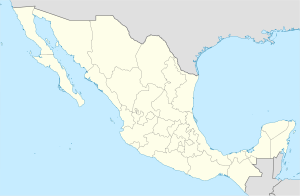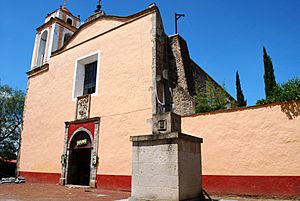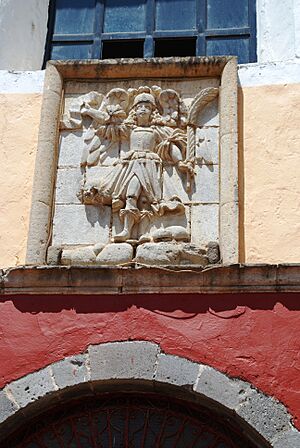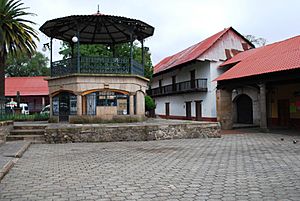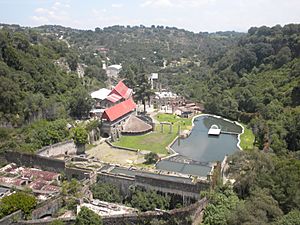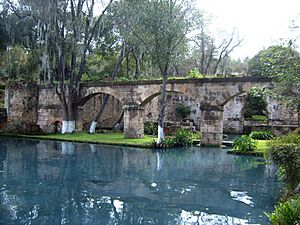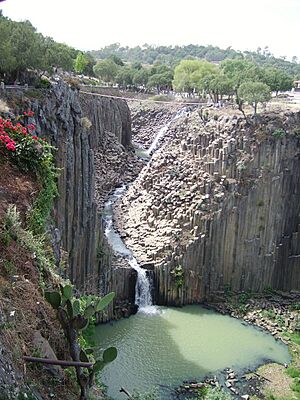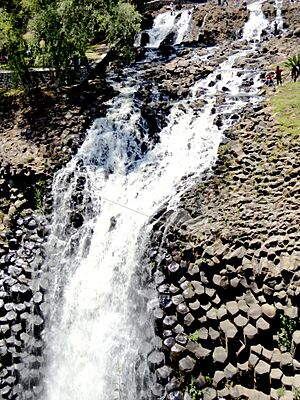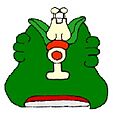Huasca de Ocampo facts for kids
Quick facts for kids
Huasca
|
||
|---|---|---|
|
Town & Municipality
|
||
| Huasca de Ocampo | ||
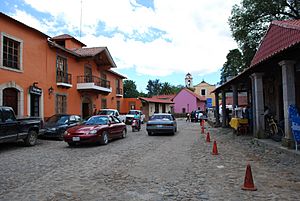
Streetview looking towards parish church
|
||
|
||
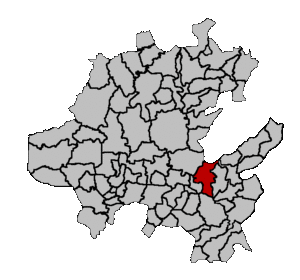
Location of the municipality of Huasca de Ocampo in Hidalgo.
|
||
| Country | ||
| State | Hidalgo | |
| Founded | 18th century | |
| Municipal Status | 1864 | |
| Elevation
(of seat)
|
2,100 m (6,900 ft) | |
| Population
(2005) Municipality
|
||
| • Municipality | 15,201 | |
| • Seat | 543 | |
| Time zone | UTC-6 (Central (US Central)) | |
| • Summer (DST) | UTC-5 (Central) | |
| Postal code (of seat) |
43503
|
|
| Website | Website | |
Huasca de Ocampo (Spanish: ['waska ðe o'kampo]) is a charming town and municipality in the state of Hidalgo, central Mexico. It's nestled in the Pachuca Mountains, about 34 km from Pachuca. Huasca is famous for its history, especially its old mining haciendas built in the 18th century. Today, it's a popular spot for tourists, especially those from Mexico City, who come to enjoy its beautiful canyons, traditional buildings, and waterfalls. It was the first town in Hidalgo to be named a "Magical Town" because of its well-preserved past.
Contents
What's in a Name?
The original name for this area was "Huascazaloya." This name comes from the Nahuatl language and can mean a few things.
- The most likely meaning is "place of happiness and abundance."
- Another idea is "place of water."
- A third meaning suggests "place where they make precious cotton shawls."
The "de Ocampo" part was added to honor Melchor Ocampo, a famous person who lived there for a short time in the mid-1800s.
A Glimpse into Huasca's Past
The first records of Huasca de Ocampo date back to the early colonial period. The land was part of an encomienda (a Spanish land grant) given to the Diego de Paz family in 1558. In the late 1500s, the area was recognized as an "Indian Republic," which meant the native people had some freedom from Spanish rule. Later, in the 1600s, the land was divided into haciendas.
Mining and Haciendas
The town of Huasca really grew between the 1760s and 1780s. This was when Pedro Romero de Terreros, who was the first Count of Regla, started mining operations here. His mines, along with others in Pachuca and Real del Monte, made him one of the richest people in the world!
Romero built four large mining haciendas in the area. The biggest ones were San Miguel Regla and Santa Maria Regla. Thousands of workers were employed to build and run these haciendas. However, after Romero's death in 1781, the mines faced problems due to poor management. By 1810, mining production dropped a lot. People started renting out the land for cattle farming, but this also caused damage to the environment. Many buildings fell into ruin, and people began to leave the area.
From Mining to Tourism
Since the mid-1800s, farming has been the main way people make a living. The large haciendas were broken up, and much of the land became ejidos, which are lands owned in common by local communities.
In the late 1900s, the main buildings of Santa Maria Regla and San Miguel Regla were turned into fancy hotels and resorts. The San Antonio Hacienda is now mostly underwater because of dams built in the 20th century to store water and make electricity.
Today, very few people in Huasca speak an indigenous language. In 2005, only 64 people did. Besides farming, ecotourism (tourism focused on nature) has become very important. Huasca de Ocampo was the first town in Hidalgo to join the "Magical Towns" program. This is because many of its old buildings are still standing, and life there hasn't changed much since the early 1900s.
However, the popularity of tourism has also led to some challenges. There have been disagreements over land ownership between long-time residents and people who want to buy land, especially near the old Santa María Regla hacienda. Many families have lived on these lands for over 200 years.
Exploring Huasca Town
The town of Huasca de Ocampo is located at the edge of the Sierra de Pachuca mountains. The town is surrounded by low, forested hills. As you leave the town to the east, the landscape opens up into a wide valley.
The town center has narrow streets and buildings made of white sandstone. They have sloped roofs covered with red metal or clay tiles. The walls are thick, built with large stones. This style is common in older mining areas of Hidalgo, where it rains often. Some buildings are decorated with smooth river stones, and many shops have wooden accents with the bark still on. The streets are paved with stone, and there aren't many streetlights at night, giving it a cozy feel.
In the middle of town is the main church. Many people think it's dedicated to the Archangel Michael because of a carving above the main entrance. But it's actually dedicated to John the Baptist. This church was built in the early 1500s by Augustinian monks. The carving of the Archangel Michael was a gift from Pedro de Terreros. Inside, the side altars are made of wood and are thought to be from the 1700s.
Local Crafts and Flavors
Huasca is known for its pottery, made from local red clay. Most pieces are everyday items like jars, plates, and cups. You can find these at the weekly market, called a tianguis. Famous potters include Jesús Chavez Centeno and Luis Escorz, whose shops are near the church.
Other crafts include hats, molcajetes (grinding tools) made from volcanic stone, furniture, and items made from obsidian. You can also find rompope, a traditional Mexican drink. The Casa de Cultura, south of the church, also sells local crafts.
Monday is market day in Huasca. Vendors set up stalls along the main street, selling local products. At the market and in restaurants, you can try traditional foods like:
- Baked trout
- Cecina (salted, dried meat)
- Barbacoa (slow-cooked meat)
- Pastes (savory pastries)
- Quesadillas with huitlacoche (corn fungus)
- Pulque bread
- Fruit wines
During certain seasons, you might find special dishes like chinicuiles (maguey worms), escamoles (ant larvae), and dishes made with local wild mushrooms.
The town has more than fifteen inns and hotels for visitors. The festival of John the Baptist is celebrated on June 24th with masses, charreadas (Mexican rodeos), horse racing, and fireworks. Another important event is the feast day of the Virgin of Guadalupe. During these festivals, you might see traditional clothing, like embroidered cotton shirts and pants.
The Huasca Municipality
While the town of Huasca de Ocampo is the main center, most of the municipality's 15,201 people (as of 2005) live in over 80 other communities. The municipality covers an area of 305.80 square kilometers. It borders other municipalities like Tulancingo and Omitlán de Juárez, and even the state of Veracruz to the north.
The municipality stretches from the Sierra de Pachuca mountains, where the town is, to a wide, flat valley. This valley has a lower altitude and warmer temperatures, filled with small villages, fields, and orchards. Higher areas are covered with holm oak forests. The altitude in the municipality ranges from 1,800 to 2,800 meters above sea level. About 70% of the municipality is part of the Trans-Mexican Volcanic Belt, but there are no active volcanoes here.
Nature and Wildlife
About 3,300 hectares of the municipality are covered by forests, mostly in the Sierra de Pachuca Mountains. Important peaks include Cerro Grande and La Peña del Aguila. There are many small canyons and ravines with jagged mountainsides. One peak, Los Pelados, offers amazing views of the municipality.
The municipality has many small rivers, streams, and arroyos (small creeks) that usually flow north-south. The largest rivers are the Huascazaloya, Iztla, Hueypan, and San Jeronimo. These waterways feed 87 natural and man-made bodies of water, from small ponds to lakes a couple of kilometers long. The San Antonio Regla dam is well-known, and its water is mainly used for farming. A major freshwater spring is called Ojo de Agua, surrounded by large willow trees.
The rivers and streams have carved deep, narrow ravines and canyons. The largest is the San Sebastian Canyon, part of the Metztitlán Canyon system. The climate is generally mild, with an average temperature of 15°C. Winters can be cold, especially at night.
You'll find different types of plants here. Pine and holm oak trees grow in higher areas. The flat areas are mostly grasslands and farms with scattered trees like willows. Wildlife includes small mammals like badgers, squirrels, foxes, and moles. You might also see birds like eagles and reptiles like chameleons.
Huasca's Economy
In the past, mining and farming were the most important economic activities. While mining is no longer as big, farming is still very important, employing over 37% of the people in the municipality. Over 17,000 hectares of land are used for production. The most important crop is corn, followed by animal feed, beans, wheat, and alfalfa. You can also find fruit orchards. Farmers raise animals like chickens, sheep, goats, pigs, turkeys, cows, horses, and bees.
Today, about 35% of the population works in commerce, which includes tourism and services for local people. This part of the economy has been strongly supported by the government.
Fun Things to Do in Huasca
The Hidalgo state tourism authority promotes Huasca as part of the "Corredor de la Montaña" (Mountain Corridor). The town is also a federal "Pueblo Mágico" (Magical Town) because of its well-preserved architecture and natural beauty. These efforts have helped make the area more appealing to visitors. Most tourists come from Mexico City, which is only about 1 hour and 40 minutes away by car.
Ecotourism and the old haciendas are the main attractions. You can enjoy activities related to the lakes, mountains, and canyons, such as fishing, boating, hiking, and horseback riding. The haciendas, many built by Pedro Romero de Terreros, have even been used as filming locations for movies and TV shows. Tours to most attractions start from the town of Huasca, especially on weekends.
Santa María Regla Hacienda
Pedro Romero de Terreros built four mining haciendas in this area. Santa Maria Regla was the largest, costing a huge amount of money at the time. Construction began in 1762 as a silver mining operation. The hacienda was named after the Virgin Mary, who was honored in Romero's hometown in Spain.
Rocks from the mines were brought here to be crushed and treated with mercury to get the silver out. This process needed a lot of water, which came from local streams. Forests provided wood to melt the silver into bars. The hacienda covers twelve hectares at the bottom of a canyon, very close to the Basaltic Prisms. At its peak, it employed up to 2,000 workers.
This hacienda was Romero's home in the area, and he died here in 1781. Alexander von Humboldt, a famous explorer, visited Santa María Regla in 1803. He drew sketches of it, including the Basaltic Prisms, which were part of the property. His drawings and writings were published in Europe, making him one of the first people to promote tourism in the area. His original drawings are now in the British Museum in London.
The main entrance of the hacienda has an image of the Archangel Michael. Many original buildings are still preserved, like the main house, smelting ovens, tunnels, and the chapel. The hacienda was turned into a hotel in 1945. Much of the property is now underwater due to a nearby dam. The hotel offers picnic areas, a restaurant, horseback riding, and guided tours. You can also see old mining equipment, and the chapel can be rented for events. They even raise trout for the restaurant! This hacienda has been used in movies like The Mask of Zorro.
San Miguel Regla Hacienda
Another famous hacienda is San Miguel Regla, located just outside Huasca town. Romero also built this hacienda in the 1700s for mining. Many of its original structures are still there, such as the five-meter stone wall around it, the arches of the main courtyards, the main house, and the gardens.
Most of the land that once belonged to San Miguel Regla is now ejido land (communal land). However, the hacienda complex has been turned into a hotel and ecotourism park. The main house is a luxury hotel with small villas connected by walking paths. The gardens are kept as they were in the 1700s, with a modern heated swimming pool added. There's also a tennis court, a bar, and a Greek-style theater by the lake.
Basaltic Prisms of Santa María Regla
The Basaltic Prisms of Santa María Regla are amazing tall columns of basalt rock. They line a canyon where water flows from the San Antonio Dam. This area was part of the Santa María Regla Hacienda and was first made famous by Alexander von Humboldt in 1803.
The canyon walls, called the Barranca de Alcholoya, are covered with these polygonal columns, which are between thirty and fifty meters high and have five or six sides. These basalt columns formed when volcanic lava cooled very slowly. There are two waterfalls here. The higher one gets extra water from nearby dams. The lower one is called the Cascada de la Rosa. The canyon has stairs, walkways, and hanging bridges, making it easy for visitors to explore.
Other Exciting Attractions
- San Antonio Regla Hacienda: This hacienda was also built by Pedro Romero de Terrero for mining. Today, it's almost completely underwater because of the San Antonio Dam. All you can see is a tall smokestack sticking out of the water!
- San Juan Hueyapan Hacienda: This was one of the first haciendas built in Mexico, started by a nephew of Hernán Cortés in 1535. It was used for farming and raising animals. You can still see its old taverns, stables, and chapel.
- El Zembo: Located seven km from Huasca, this spot is in a small valley surrounded by forests. It has a trout farm and rustic restaurants that prepare fresh fish. You can even catch your own trout!
- Parque de las Truchas (Trout Park): Also called Bosque de las Truchas, this park offers fishing, canoeing, and horseback riding. They raise trout here, importing eggs from the United States because the local waters are a bit too cold for them to hatch naturally.
- Peña del Aire: This is a huge basalt rock that sticks out from the side of a canyon, just north of the Santa María Regla Hacienda. It looks like it's floating in the air, which is how it got its name. It's 800 meters above the canyon floor. Near here, you can go rappelling, mountain climbing, and hiking.
- Museo de los Duendes: Just outside Huasca town, this museum is dedicated to stories of goblins and similar creatures. It's run by María de los Angeles, who shares legends about these creatures. A big part of the collection includes goblin figures made from horse hair.
- Aguacatitla Canyon: This canyon is great for rappelling, hiking, and rock climbing.
- El Huariche: This is an ecotourism spot on ejido land, offering cabins and camping areas surrounded by pine forests.
- Hot Air Balloon Tours: You can even take a hot air balloon tour over the area with companies like Club Aerostático Nacional and Club de Aeronautas de México.
Images for kids
See also
 In Spanish: Municipio de Huasca de Ocampo para niños
In Spanish: Municipio de Huasca de Ocampo para niños



